A Christian Defense of Tarot Cards
An analysis of Tarot for what it is: a perfect set of pictures that help us think.
I have been thinking about writing this piece for a while, but I have been too nervous to do it until now. Tarot cards are an extremely taboo subject in Christian circles. While I have previously written about Christian symbolism within Tarot cards, I never actually held a deck with my own hands before… until now.
For the sake of transparency, I will make a public confession: Last week I bought my first deck of Tarot cards for personal research.1
Several people from my parish read my Substack, including my priest (who I am sure would like to have a word with me after he reads this). I’m sure a few of them will be shocked to see this article title pop up in their email, causing them to be concerned for my spiritual well-being. The mere mention of the word invokes images of witches and psychics in their seedy stripmall magic shops — servants of the devil dwelling in their dens of iniquity.
I don’t think that my fellow Christians are wrong to be concerned. In fact, I am grateful that I have people in my life that are willing to hold my soul accountable.
But I ask them to suspend their judgement for a brief moment and hear me out; this isn’t going to be as bad as you think.
Because here is a hard fact — one study on Gen Z showed that young Russian and Greek Orthodox Christians are the religious group most likely to use Tarot cards:
Springtide’s survey showed that 51 percent of its sample population, age 13–25, engage in tarot cards or fortune-telling. Of that percentage, 17 percent practice daily, 25 percent once a week, 27 percent once a month, and 31 percent less than once a month.
Interest in tarot and other forms of divination doesn’t necessarily correspond with a rejection of traditional religion. Many young tarot readers continue to identify with a traditional faith, while looking beyond established structures for spiritual growth.
According to Springtide’s report, divination practices are most popular among young people who identify as Russian or Greek Orthodox (78.1 percent), Mormon (69.4 percent), or Jewish (62.1 percent). Atheists had the lowest interest in metaphysical-adjacent practices at 34.4 percent, followed closely by those identifying with no particular faith tradition […]
The popularity of alternative spiritual practices among Orthodox youth is cultural, explained Jenny Haddad Mosher, director of the Telos Project, an effort by the Greek Orthodox Church in America to foster the faith among young people.
“Fortune-telling practices are extremely widespread amongst people of all religions in Greece, Turkey, and the Middle East,” she said. Orthodox youth who are used to seeing their grandparents reading fortunes in coffee grounds, she suggested, see little to no religious stigma in other incarnations of this tradition.
I can verify that I have seen this “old country” mentality about fortune-telling firsthand. I know one elderly Egyptian man at my parish, one of the most devout and pious people I have ever met, yet he has read coffee grounds for some of our fellow parishioners. I’ve also heard people at my parish tell stories of older Greek Orthodox women reading people’s tea leaves. These activities weren’t really taken too seriously, it was seen as more of a harmless past-time than anything else. No one was scared that these people were contacting demons.
There is a morbid curiosity that young Christians have about Tarot cards. The blanket answer which says “all of it is demonic” is not a good enough answer to keep people away from them. I find it ironic that Orthodox Christianity has the most behavioral prescriptions out of any denomination, yet its young folks are the most likely to engage in these behaviors.
Anyone who has raised children knows that saying “because I said so” is not going to stop your kids from doing something. Therefore, a more nuanced and informed view on the topic is necessary in order to de-fang the allure that Tarot cards have, preventing them from becoming a forbidden fruit which is all the more tempting.
So in order to separate the wheat from the chaff, I am going to dissect the phenomena of Tarot cards in order to illustrate the fine line which separates what should and should not be done by the faithful.
I humbly ask my fellow Christians to hear me out, put the knee-jerk reactions to the side, and look at this subject matter with an open mind.
Examination and Condemnation of Divination
It is not my wish to scandalize any of my fellow Orthodox Christians by writing this, so I will be extremely clear from the outset: I am NOT condoning or defending the practice of divination.
Divination is clearly condemned by the Bible and the Church. But what exactly is divination? In the Bible, divination is often also translated as “fortune-telling” or “sooth-saying.”
The Oxford Dictionary defines divination as: “the practice of seeking knowledge of the future or the unknown by supernatural means.”
I did not buy these cards for the sake of trying to foresee the future or gain some sort of secret knowledge within the natural world.
But for the sake of further clarifying that I am not communing with demons, I wish to explore the mechanisms behind divination itself and define what kind of behaviors the Bible condemns.
Essentially, divination is the practice of analyzing patterns within seemingly random natural phenomena in an attempt to extrapolate those patterns onto a separate and unrelated natural phenomena. Examples of divination which were common in the ancient world include: killing an animal and reading its entrails, burning animal bones or turtle shells and studying the cracks, examining the flight patterns of birds, astrology, etc.
(Funny enough, card reading was probably not one of these ancient methods. The mass printing of playing cards is modern luxury made available by the printing press. The Rider-Waite Tarot deck, the most popular one everyone is familiar with, wasn’t created until 1909.)
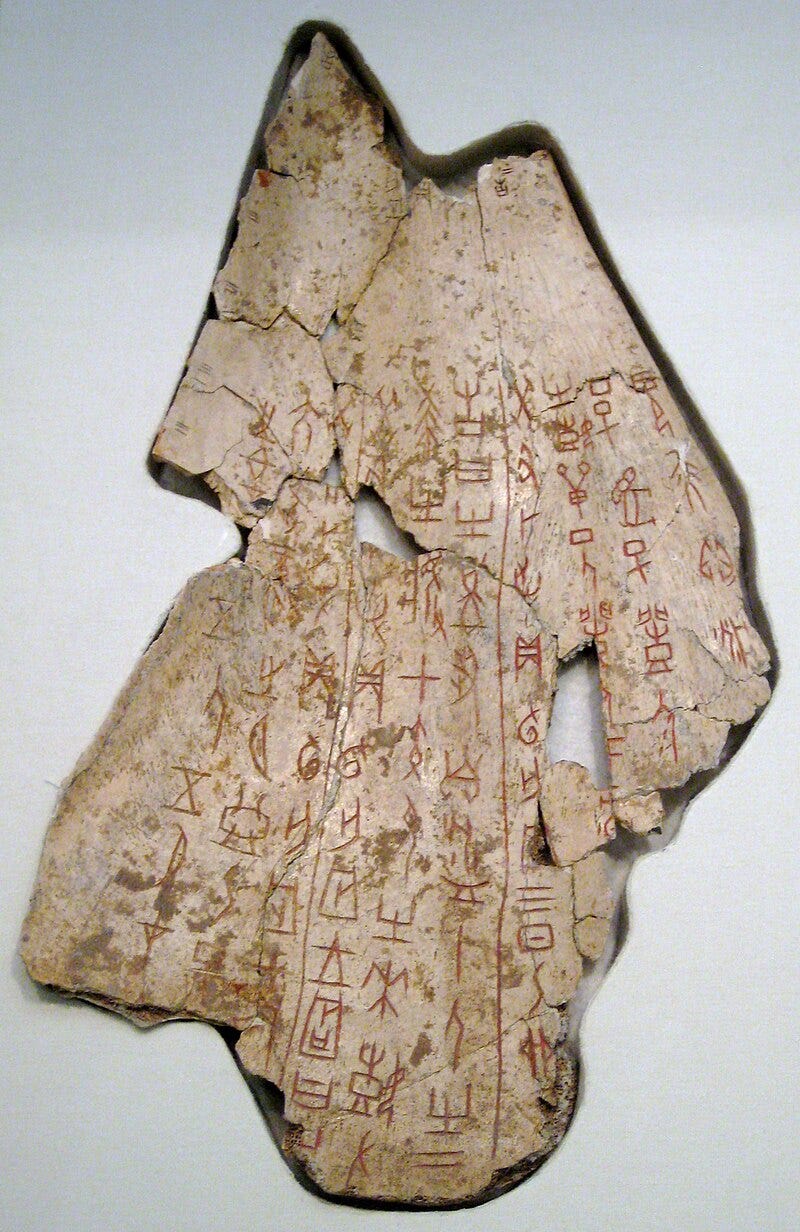
In layman’s terms, divination is the practice of taking patterns from one observation and applying them to something else that has no causal relationship. A soothsayer would look at chicken entrails and tell you who you will get married to, or examine a cracked turtle shell and predict that there will be a drought this year.
Did these practices actually work?
Well… kinda. But if they ended up working, it was for unseemly reasons.
In my research, I’ve deduced three major reasons for why and how fortune-telling “works”:
Future events that are under the control of the human’s free will are subject to self-fulfilling prophecy. Once a fortune is told, it lingers in the subconscious mind of the person who receives it. This causes the actions of the person to autonomously gravitate towards fulfilling the prediction without them consciously knowing it, making it seem like this prediction was “fated.”
Individuals with a strong intuition already had a hunch that these future events were going to happen, they just projected that intuition onto the divination medium.
The deity which the fortune-teller invokes provides the information. This demonic spirit will feed intuitions into nous (eye of the soul) of the soothsayer. Once these demonic intuitions are fed into the readers psychic eye, the patterns within the divination medium (i.e. cracks in oracle bones) serve as a symbolic “alphabet” through which these intuitions can be externally articulated. Demons are ancient disembodied intelligences who have seen patterns and cycles play out for thousands of years, meaning that are very good at extrapolating these patterns into the future.
In all of these cases, the chosen divination medium acts as a “projection screen” for the intuition of the reader.
Let’s make up an example: someone consults a fortune-teller and asks if they will get a raise at their job this year. The fortune-teller will invoke their deity (modern New Age spiritualists will call this their “spirit guide”) and ask them to reveal the information to them. The demon will place the answer into the persons heart, where our intuitive faculty is, causing the fortune-tellers intuition to be subject to selection bias. They will perceive symbols in the bones or entrails which resemble answers to the subject matter at hand. Since the client in this case is asking about a financial question, the soothsayer will begin to see symbols for gold, silver, prosperity, poverty or anything else related to the financial matters.
Demons can’t see the future, they are just extremely good at guessing. God is the only one who truly knows the future, which is why only the saints who possess the Holy Spirit receive the gift of clairvoyance from God. God’s Spirit is the one who feeds their heart these intuitions, not demons.
This is why divination is rightfully condemned in Christianity: at best it is delusional superstition based on guesswork and at worst it is communion with the demonic.
Divination vs. Casting Lots
Before we dive into the Tarot deck, I would like to draw a distinction between divination and casting lots. To “cast lots” is to leave a decision up to random chance.
Most of us have had moments in our lives when we can’t decide on something, so either flip a coin, roll the dice, draw straws, break a wishbone, or some other activity that leaves our actions in the hands of fate. Is this unlawful in the eyes of God?
The reality is this: interpreting God’s will by interpreting random chance is something that is found throughout the Bible and Church history.
In the Old Testament, the high priest in the tabernacle of Moses or the temple of Solomon possessed something called the Urim and Thummim. These two objects were kept behind the priest’s breastplate and were used to discern God’s will. They were most likely stones or something similar. The exact method of using them is unknown since the Bible does not explicitly tell us, but most scholars concur that it was most likely some form of casting lots or divination. I will lazily copy-and-paste a paragraph from Wikipedia which explains why this is believed to be the case:
1 Samuel 14:41 is regarded by biblical scholars as key to understanding the Urim and Thummim; the passage describes an attempt to identify a sinner by repeatedly splitting the people into two groups and identifying which group contains the sinner. In the version of this passage in the Masoretic Text, it describes Saul and Jonathan being separated from the rest of the people, and lots being cast between them; the Septuagint version, however, states that Urim would indicate Saul and Jonathan, while Thummim would indicate the people. In the Septuagint, a previous verse uses a phrase which is usually translated as "inquired of God", which is significant as the grammatical form of the Hebrew implies that the inquiry was performed by objects being manipulated; scholars view it as evident from these verses and versions that cleromancy was involved, and that Urim and Thummim were the names of the objects being cast.
Now, one could argue that this was during the Old Covenant before Christ’s incarnation. This was merely a shadow from the past that we can dispose of since we have direct revelation from God.
However, we can look to the New Testament and find the apostles casting lots to see who would replace Judas. There were many candidates, but they narrowed it down to two:
And they proposed two: Joseph called Barsabas, who was surnamed Justus, and Matthias. And they prayed and said, “You, O Lord, who know the hearts of all, show which of these two You have chosen to take part in this ministry and apostleship from which Judas by transgression fell, that he might go to his own place.” And they cast their lots, and the lot fell on Matthias. And he was numbered with the eleven apostles.
- Acts 1:23-26
The apostles interpreted the answer of the lot to be the will of God. The apostles clearly prayed on this matter intensely, but why didn’t God just divinely reveal the answer to them within their hearts? One could argue that this was a few days before Pentecost and the apostles did not yet receive the Holy Spirit and the divine gifts which came with it. Therefore, they needed to rely on more primitive methods of discerning God’s will.
However, this method of choosing Matthias lasted throughout the Orthodox tradition and has been used by clergy within the Church to decide who should be appointed as the next bishop. In fact, the modern day Saint Tikhon was one of three candidates elected to be patriarch of Moscow in 1917; he was selected for the position after the bishops cast lots to determine who they would pick. I’ve also heard of instances in Greece where bishops will put the names of episcopal candidates in a box, put the box in front of an icon of the Mother of God overnight, then draw a name from the box. This was viewed as the Virgin Mary interceding and choosing the next bishop.
It is important to note that these three examples all have one thing in common: pious prayer to God preceded the casting of lots. This was done as a last resort after all other measures were taken.
In my personal opinion, I don’t think these instances could be defined as “divination” because there was no predicting the future or seeking information which was externally unavailable. Scholars may disagree, but I digress.
Now that we’ve cleared up our definitions here, let’s get to the meat of the subject matter:
When I title this article “A Christian Defense of Tarot Cards,” what exactly am I defending here? Why did I buy these cards and what am I doing with them?
Tarot as a Meditative Tool
Here’s a funny question: what would the Church Fathers say about Rorschach tests?
These inkblot tests, which originate from the psychoanalyst paradigm of the early 20th century, have become infamous icons within pop culture. I believe it is because they serve as the perfect microcosm of psychoanalytic theory, representing one of its central subjects: the study of psychic projection.
The blots themselves are entirely random and ambiguous, yet their forms are defined enough to resemble various real life objects. This makes them the perfect vehicle for us to project our thoughts onto them.
The fact is: we see ALL of reality this way.
We never actually perceive the “objective” outside world; we only perceive things which comport with the thoughts in our minds. Several modern Orthodox elders have commented on the need to cultivate good thoughts, because our thoughts determine our lived experience of external reality.
“Our life depends on the kind of thoughts we nurture. If our thoughts are peaceful, calm, meek, and kind, then that is what our life is like. If our attention is turned to the circumstances in which we live, we are drawn into a whirlpool of thoughts and can have neither peace nor tranquility.”
― Elder Thaddeus of Vitovnica
Some people tell me that they are scandalized because they see many things wrong in the Church. I tell them that if you ask a fly, “Are there any flowers in this area?” it will say, “I don’t know about flowers, but over there in that heap of rubbish you can find all the filth you want.” And it will go on to list all the unclean things it has been to.
Now, if you ask a honeybee, “Have you seen any unclean things in this area?” it will reply, “Unclean things? No, I have not seen any; the place here is full of the most fragrant flowers.” And it will go on to name all the flowers of the garden or the meadow.
You see, the fly only knows where the unclean things are, while the honeybee knows where the beautiful iris or hyacinth is.
As I have come to understand, some people resemble the honeybee and some resemble the fly. Those who resemble the fly seek to find evil in every circumstance and are preoccupied with it; they see no good anywhere. But those who resemble the honeybee only see the good in everything they see. The foolish person thinks foolishly and takes everything in the wrong way, whereas the person who has good thoughts, no matter what he sees, no matter what you tell him, maintains a positive and good thought…
— St. Paisios the Athonite
And this is exactly what Tarot cards are good for. They are essentially an interactive Rorschach test that allows us to explore the internal contents of our unconscious minds and help us understand why we are perceiving external reality a certain way. Are we thinking like a fly? Or like a honeybee?
Let’s point to a Tarot card as an example. Look at this card, you don’t need to know any of the abstract symbolism about the number or the suit. Just look at it and notice within yourself whatever thoughts emerge in your mind:
What came to your mind? Surely, you have had moments like this in your life.
What is this person going through? A chronic illness? Maybe financial troubles? A divorce? Did you immediately identify with this person? Or did it remind you of someone else in your life?
The correct answer is: whatever you first thought of.
The archetype of someone being tortured by their thoughts and not being able to sleep is as old as humanity itself, which is why this card is so potent. Just by looking at it, we instantly recall several instances where we have seen or experienced this feeling.
Let’s do another one:
I’m sure completely different images arose in your mind. What is this family happy about? What occasion are they celebrating? What is the weather like?
I mentioned earlier that fortune-tellers would use entrails or bones as a “projection screen” for their intuitions. This is the same mechanism at work for reading Tarot cards.
However, there does not need to be any angels or demons involved for this process to take place. Since human beings are spiritual creatures whom God made “a little while lower than the angels,”2 we have our own independent intuitive faculties that are powerful enough to function without the help of other spirits.
Often times, our gut feelings and emotions are buried by our rational minds. We feel something deep within us, but we can’t logically make sense of it. Other times, there are thoughts that linger in the back of our minds that don’t want to be acknowledged due to how uncomfortable they are. But a picture is worth a thousand words — sometimes all it takes is a single image to provoke a reaction within us and reveal what we are really thinking.
But why use the images in Tarot cards to do it?
Tarot as an Archetypal Alphabet
Why are Tarot cards so good at aiding this process of meditating on our own intuitions? It is because the structure of the Tarot is an incredibly coherent system of symbols which adequately mirrors the archetypal structure of reality itself.
The concept of microcosm and macrocosm is extremely ancient and central to Orthodox Christian theology. It can be traced all the way back to the Old Testament, with 1st century Jewish historian Josephus explaining how the tabernacle of Moses was constructed to be a microcosm of the entire universe:
In his recounting of the Exodus narrative of the wilderness tent in Ant. 3.108-187, Josephus presents a distinctive description of the cult site as an archetype of the cosmos. Thus, when Josephus describes the physical structure of the tent, its appurtenances, and the priests’ apparel, he also explains that everything within is in “imitation and representation of the universe”. Josephus writes, for instance, that the types of material used to weave the tent’s textile portion indicate the basic elements of nature from which God made the universe. The tripartite division of the tent reflects the cosmological geography: the land, the sea, and the sky. The lampstand and the twelve loaves of bread within the tent signify heavenly bodies, and the priestly vestments reflect the nature of the universe.
- Joabson Xavier Pena, Wearing the Cosmos: The High Priestly Attire in Josephus’ Judean Antiquities
This form of sacred architecture is carried forth into the Orthodox Church:
The four parts of the interior of the church symbolize the four cardinal directions. The interior of the church is the universe. The alter is paradise, which lay to the East. […] The West on the contrary is the realm of darkness, of grief, of death, the realm of the eternal mansions of the dead, who await the resurrection of the flesh and the Last Judgement. The middle of the building is the earth.
- Mircea Eliade, The Sacred and The Profane p. 61 - 62
Likewise, the Tarot deck shares a similar microcosmic structure but in visual form. It is what Josephus described as an “imitation and representation of the universe.”
The deck contains four suits which represent the four elements: fire, air, earth and water. These four elements also correspond to the four aspects which make up the human being: earth is the body, water is the emotions, air is the mind, fire is the will.
Each suit contains 10 numbered cards each (in addition to the 4 court cards), using numerology to represent the four elements in varying instances of life. The pathway from 1 to 10 represents human progression and growth through each of one of elements. For example, the suit of Cups represents the element of water and corresponds to our inward emotions. The progression through the suit represents our journey to emotional maturity and inward peace.
The Three of Cups represents fellowship, banquet, the delight of multiple people opening their hearts to one another:
Whereas the 5 of cups represents disappointment, loneliness and emotional unfulfillment, our cups over-flowing with emotion but no one there on the receiving end:
Again, these are symbols that represent life events that everyone has experienced at one point in their lives.
For a much more in-depth look at Christian symbolism within the four suits, check out my article here:
The numbers 4 and 10 in and of themselves have deep numerological symbolism which reflect the metaphysical structure of reality.
There are four Gospels, four archangels, four living creatures surrounding the throne of God, four corners of the earth, four cardinal directions, etc. Four is the number of the created world, because it comes directly after three (which is the number of the Trinity).
Likewise, 10 represents the sovereignty of the 1 God; it is how the One fully expresses Himself. In the Old Testament, there are 10 commandments, 10 plagues of Egypt, and 10 elders which ruled over the legal system. In the New Testament, Christ heals 10 lepers and also gives a parable of 10 virgins.
There are much more numerological parallels we could draw, but that is for a separate article.
In addition to the 56 suited cards, there are 22 cards called the Major Arcana which contain potent archetypes within the psyche that transcend the elements:
For the Major Arcana of the Tarot are authentic symbols, i.e. they are “magic, mental, psychic and moral operations” awakening new notions, ideas, sentiments and aspirations, which means to say that they require an activity more profound than that of study and intellectual explanation. It is therefore in a state of deep contemplation—and always ever deeper—that they should be approached. And it is the deep and intimate layers of the soul which become active and bear fruit when one meditates on the Arcana of the Tarot […]
The Major Arcana of the Tarot are neither allegories nor secrets, because allegories are, in fact, only figurative representations of abstract notions, and secrets are only facts, procedures, practices, or whatever doctrines that one keeps to oneself for a personal motive, since they are able to be understood and put into practice by others to whom one does not want to reveal them. The Major Arcana of the Tarot are authentic symbols. They conceal and reveal their sense at one and the same time according to the depth of meditation. That which they reveal are not secrets, i.e. things hidden by human will, but are arcana, which is something quite different. An arcanum is that which it is necessary to “know” in order to be fruitful in a given domain of spiritual life. It is that which must be actively present in our consciousness —or even in our subconscious—in order to render us capable of making discoveries, engendering new ideas, conceiving of new artistic subjects.
- Meditations on the Tarot: A Journey into Christian Hermeticism, p. 10-11
As the anonymous author of that book says, the arcana are things which one must know in order to be fruitful in a certain domain of spiritual life. However, this doesn’t mean that one has to specifically study Tarot cards in order to learn about the arcana. The Tarot cards merely depict the arcana, but the arcana themselves are core aspects of reality which the deeply religious Christian has already encountered in their life.
If one examines the pictures on the cards they will find archetypes that are ever-present within the everyday life of the Christian worldview: angels, the devil, churches, the Hermit, the Pope, the four living creatures from Ezekiel, Adam and Eve, the Ark of the Covenant, the Tower of Babel, the Last Judgement, etc.
I think this is the reason why Tarot cards are so “sticky” within the collective unconscious — and the reason why over 3 out of 4 young Orthodox Christians in that survey have used Tarot cards (especially compared to only 1 out of 3 atheists).
Which leads me to my next point:
Reading Tarot Cards as a Christian
It is no coincidence that traditional Tarot cards are absolutely rife with Christian symbolism, because The Bible and the Christian worldview contain within it the entire map of reality. We worship the Logos who became incarnate as a man, He is the centerpiece in which all meaning and symbol have their reference point. He is the Word which gives all things their meaning, He is the Symbol of symbols. Therefore, the closer we get to Him through living the sacramental life of the Church, the more deeply we are able to meditate on the symbols within the Tarot.
An Orthodox Christian would feel even more deeply connected to the images in Tarot than an atheist or “spiritual” person would, because they are actually living out these symbols in their daily lives. A church, an angel icon, a communion chalice — these are things we see every single Sunday.
For an atheist, they are merely abstractions. For a Christian, they are arcana.
For instance, The Lovers card depicts Adam and Eve standing in the Garden of Eden. For someone not familiar with the details of the story in Genesis, the trees in the background wouldn’t mean anything at all. However, someone who is familiar with the story of the Fall will recognize the serpent, the Tree of Knowledge of Good and Evil, and the fig tree used to cover their nakedness. A whole new layer of interpretation is opened up to the Christian, while someone who is unfamiliar with the story will have only a surface level understanding.
Another example is the Judgement card. If someone were unfamiliar with the concept of the Last Judgement in Christian theology, they would be deeply confused by this imagery. Why is an angel playing music for all of these gray naked people? However, this image should strike fear in the hearts of the God fearing Christian. Meditating on this arcanum will call to mind the dread judgement seat of Christ, how one day our lives will end and how we must give an account for all of our actions, how we must spend every waking hour of our lives preparing for the Second Coming.
An arcanum is a “ferment” or an “enzyme” whose presence stimulates the spiritual and the psychic life of man. And it is symbols which are the bearers of these “ferments” or “enzymes” and which communicate them—if the mentality and morality of the recipient is ready, i.e. if he is “poor in spirit” and does not suffer from the most serious spiritual malady: self-complacency.
- Meditations on the Tarot: A Journey into Christian Hermeticism, p. 11
If one lives the sacramental life of the Church, they will see numerous instantiations of all the Major Arcanum within the real world.
The Fool card could easily call to mind the saints who are Fools for Christ, like St. Gabriel of Georgia. The Hierophant calls to mind the Pope or any other Patriarchs of the Church. The Emperor could be St. Constantine the Great or Justinian. The Hermit could be any monastic saint. One could make an Orthodox Christian themed Tarot deck very easily using iconography — which is why there are Christian themed Tarot decks that already exist.
Each Tarot card serves as a dense nexus point of meaning; someone who has a surface level understanding of the symbolism will only reach shallow conclusions. However, the more familiar you are with Christian symbols and theology, more interpretations of each card become available to you. The deeper your knowledge of Christ and His Church, the deeper into your soul you can reach with these images.
How I use Tarot cards as a Christian
For me, the symbols on the cards merely act as focal points for me to articulate thoughts that I was previously unable to put into words.
Before I draw any cards, I ask myself a question. The phrasing of the question is very important, because we are not trying to see into the future or gain access to knowledge which we don’t already possess within ourselves. We are merely trying to make more sense of the present moment.
So for example, I might ask myself: “How can I get less frustrated at my day job?”
If I draw the Hermit card, I might think that I need to be more monastic in my day to day life. If I draw the Wheel of Fortune card, I might think to myself that I need to trust in God’s providence and resign myself to fate. The Hanged Man might remind me that I need to crucify my passions in order to grow in wisdom.
The conclusions I reach when I meditate on the cards don’t come from some outside source — I am not receiving answers from some sort of demon and the cards themselves aren’t talking to me.
I am merely articulating things within my mind that were there the entire time.
Someone else could have seen the same card as it was drawn and come to an entirely different conclusion based on the contents of their own psyche.
Conclusions
I see many modern Christians today wholesale condemn Tarot cards as if they were inked with blood and printed in hellfire by the devil himself. I noticed that the more superstitious Protestant types on social media believe that if you even touch a Tarot card (or accidentally hit a yoga pose) you are going to become possessed by demons.
To their credit, their beliefs are not entirely unfounded. The symbols within Tarot cards can be used to interface with demonic intuitions, but so can any other medium.
However, the people who are terrified by the “demonic” power of Tarot cards are in the same category as those who treat the Tarot cards as some sort of supernatural oracle. They are two sides of the same coin: they give the cards themselves too much power.
At the end of the day, Tarot cards are just cards. They are merely pieces of paper with pictures on them.
Food is not evil, but gluttony is. Childbearing is not evil, but fornication is. Money is not evil, but avarice is. Glory is not evil, but vainglory is. Indeed, there is no evil in existing things, but only in their misuse.
- St. Maximus the Confessor
As a physical object, they are no different than a standard deck of playing cards we would use to play poker. The things which happen within the inward parts of our soul are what is truly important.
And I’ll be honest, the mysterious allure has been de-fanged. It was kind of exciting to play around with these cards at first, doing readings for myself and other people. But after a week or so… I’ve gotten somewhat bored with them. Going to Church is far more fulfilling.
If you still aren’t sold on Tarot cards being compatible with Christianity, Meditations on the Tarot: A Journey into Christian Hermeticism is an absolutely fantastic book which I can’t recommend enough. This resource gives us an extremely deep dive into how the extremely potent archetypes within the Tarot can help us deeply meditate upon Orthodox/Catholic theology and the dogmas of the Christian faith. The anonymous Catholic author of this book excellently references Holy Scriptures numerous times throughout the text, showing how the meaning of these cards are only fully understood in Christ. (Here is a link to the full book in PDF which you can read for free on your computer).
I will most likely write more about Tarot symbolism in the future, be on the look out!
As soon as I got home with the cards I went to my icon corner and washed them off with holy water. I got them from a highly questionable “spiritual shop” and I could feel the unclean spirits attached to them. As soon as I washed the box off, I felt a palpable sigh of relief as these spirits left the physical deck. I later used incense, which I had first used to cense all my icons, to further purify the deck. Call me crazy or superstitious, but spirits CAN attach themselves to physical objects and we must be very careful with these sorts of things.
Psalm 8:5 and Hebrews 2:7

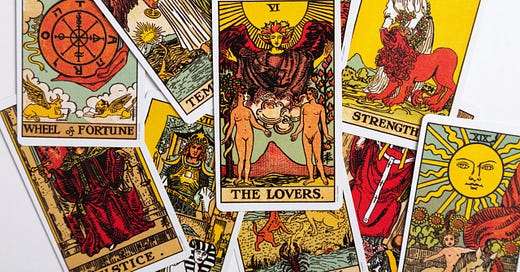


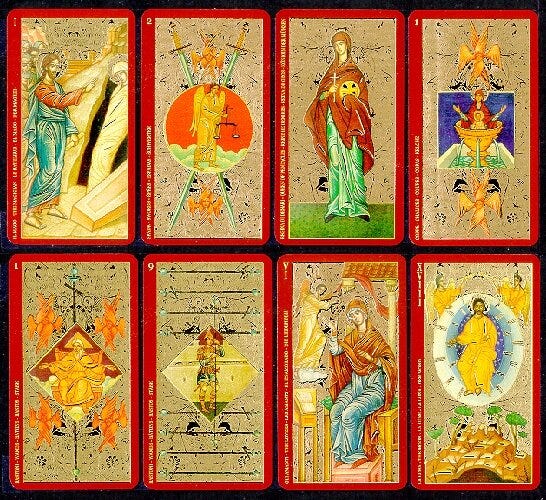
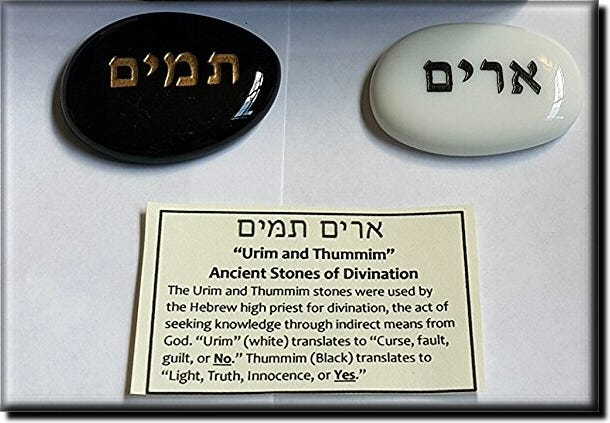
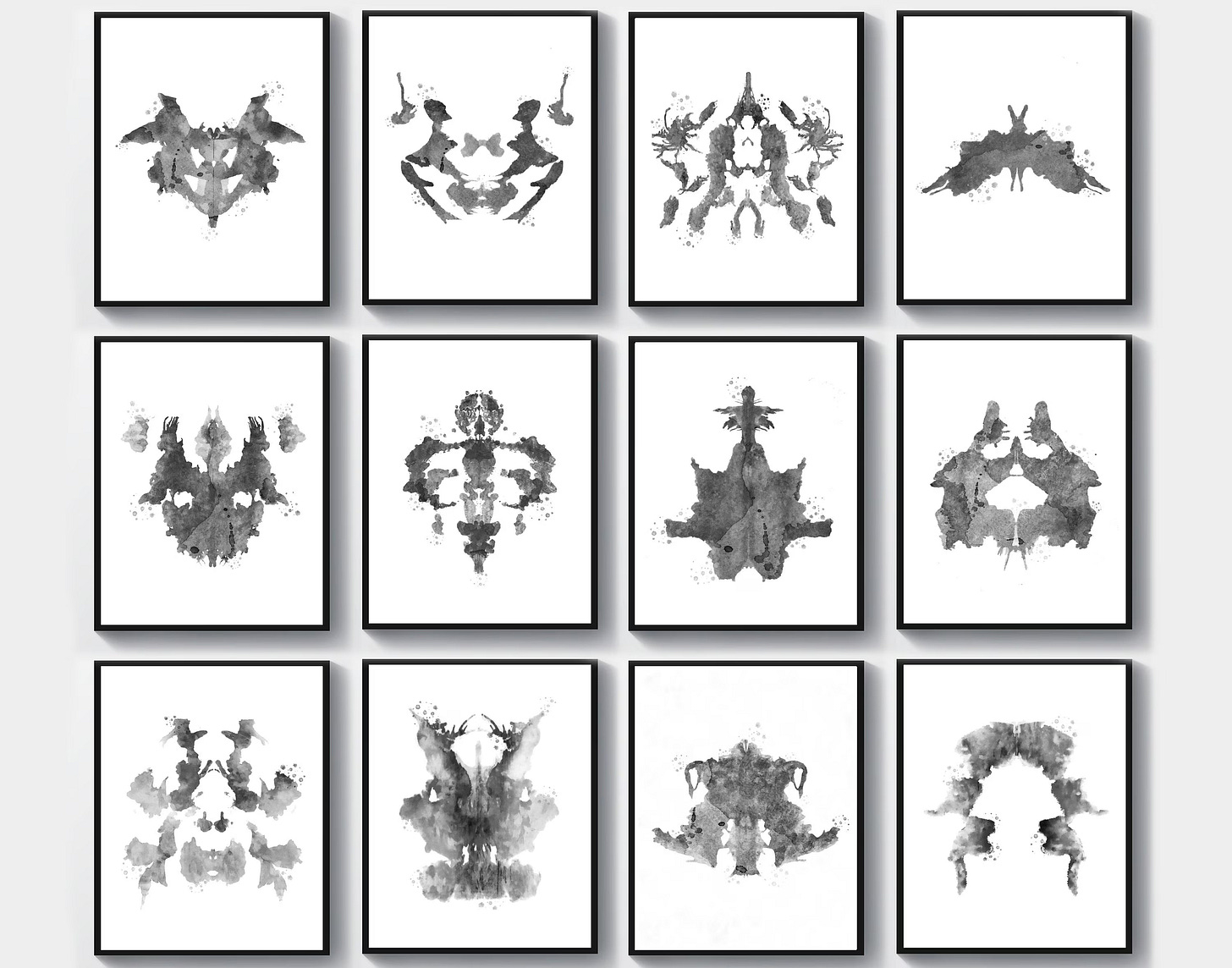
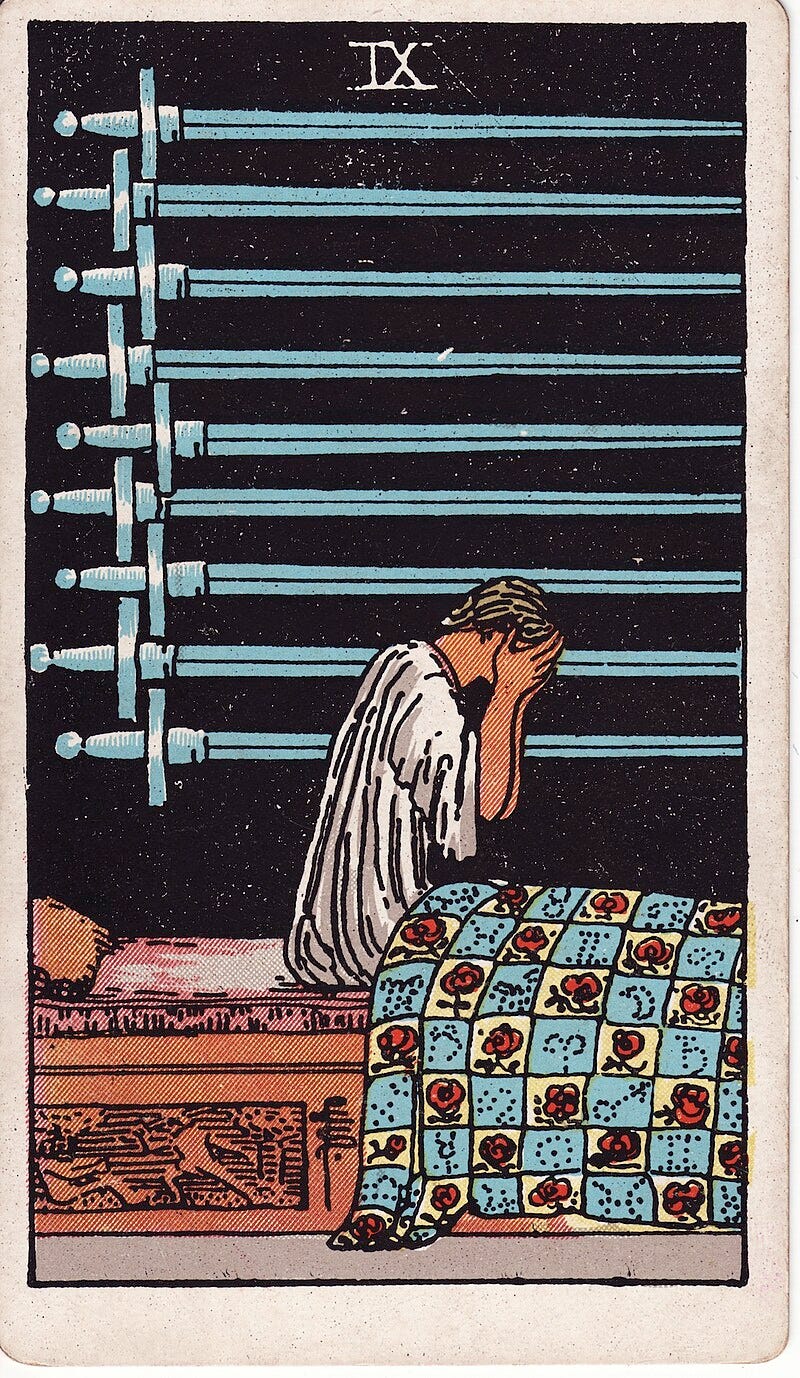
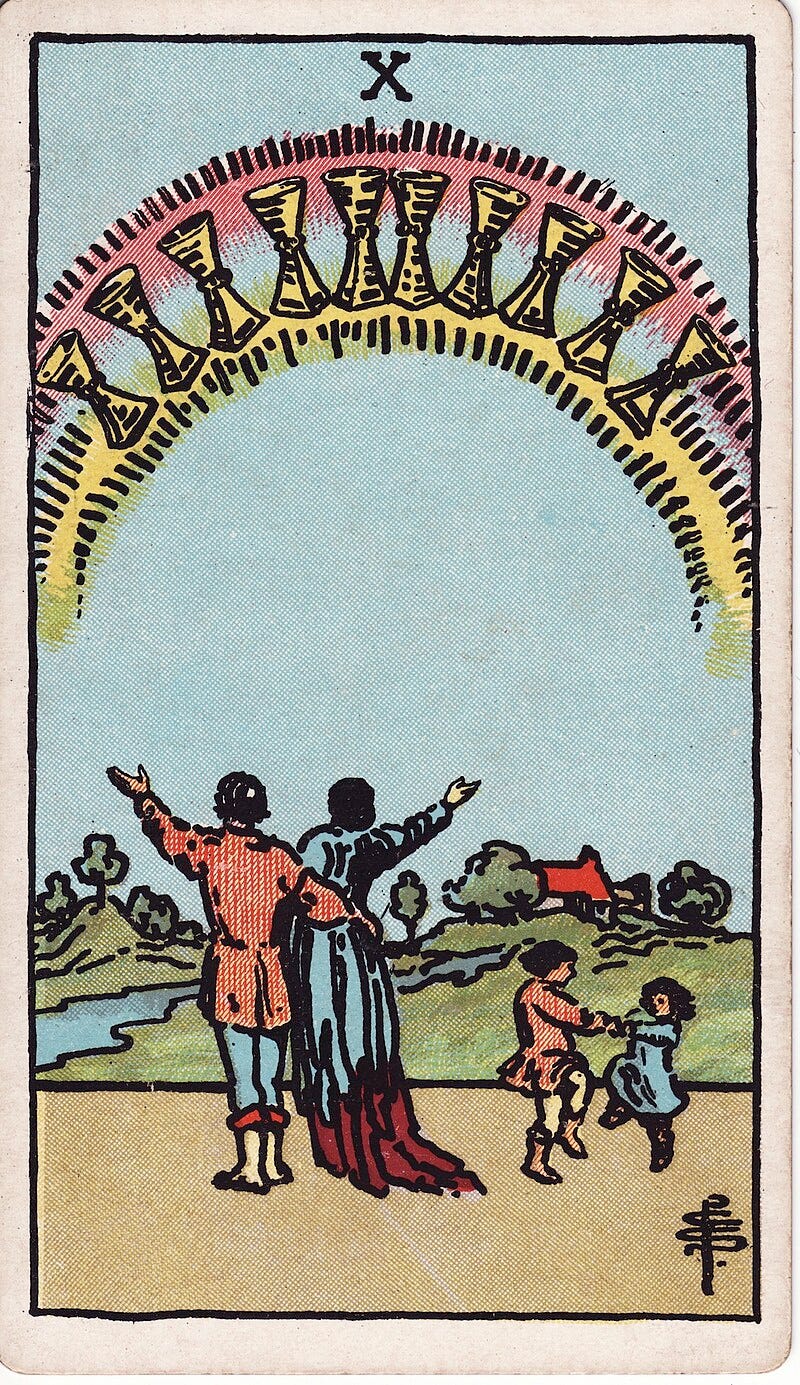

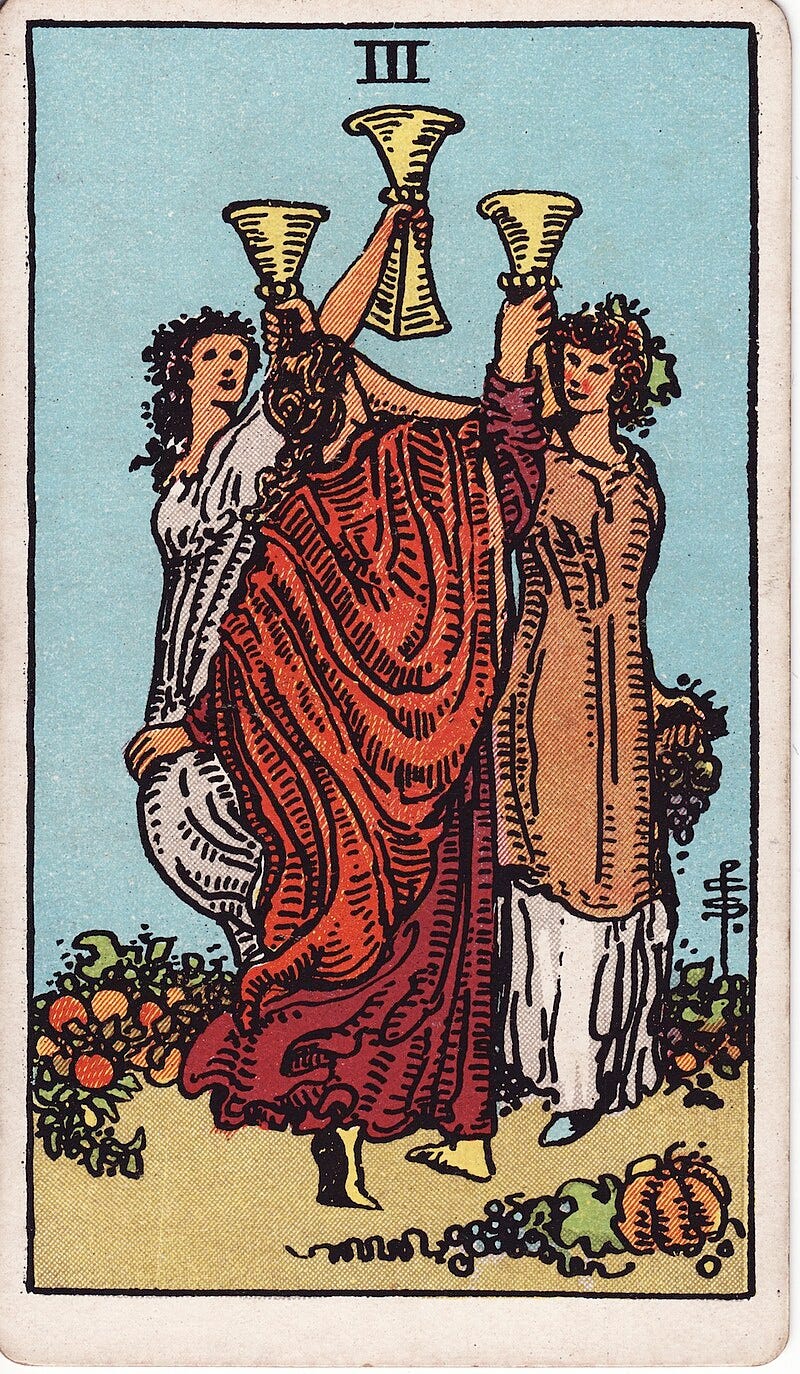
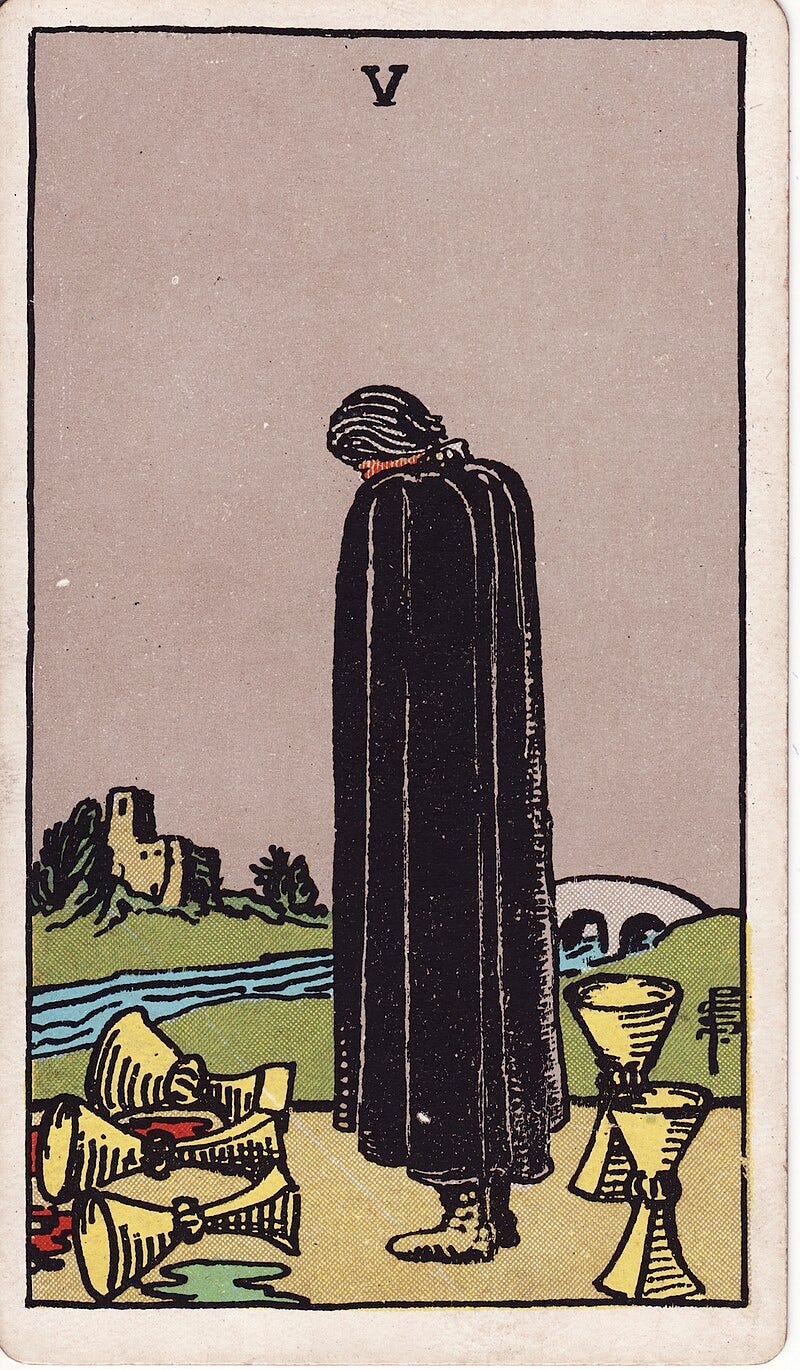


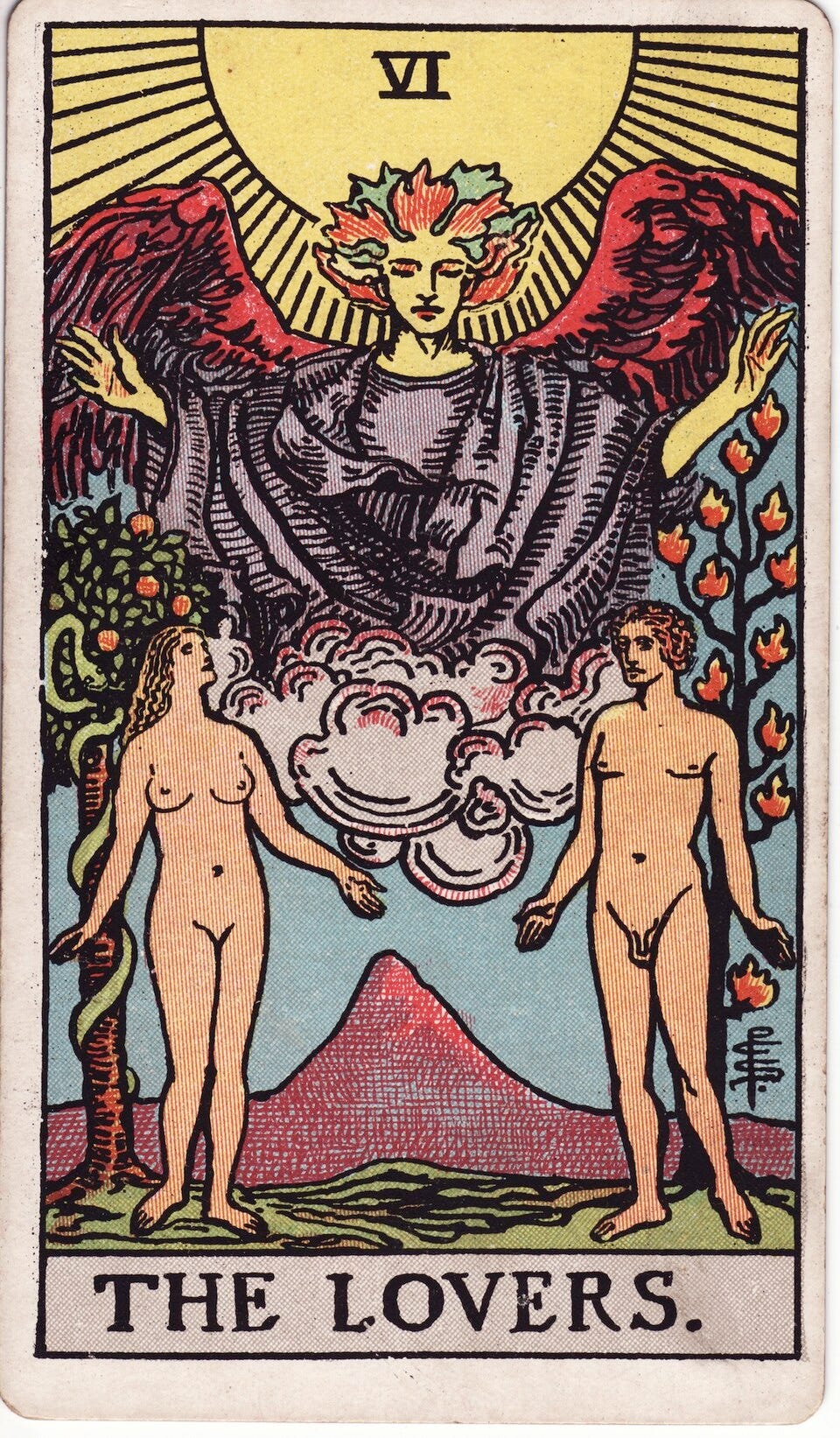
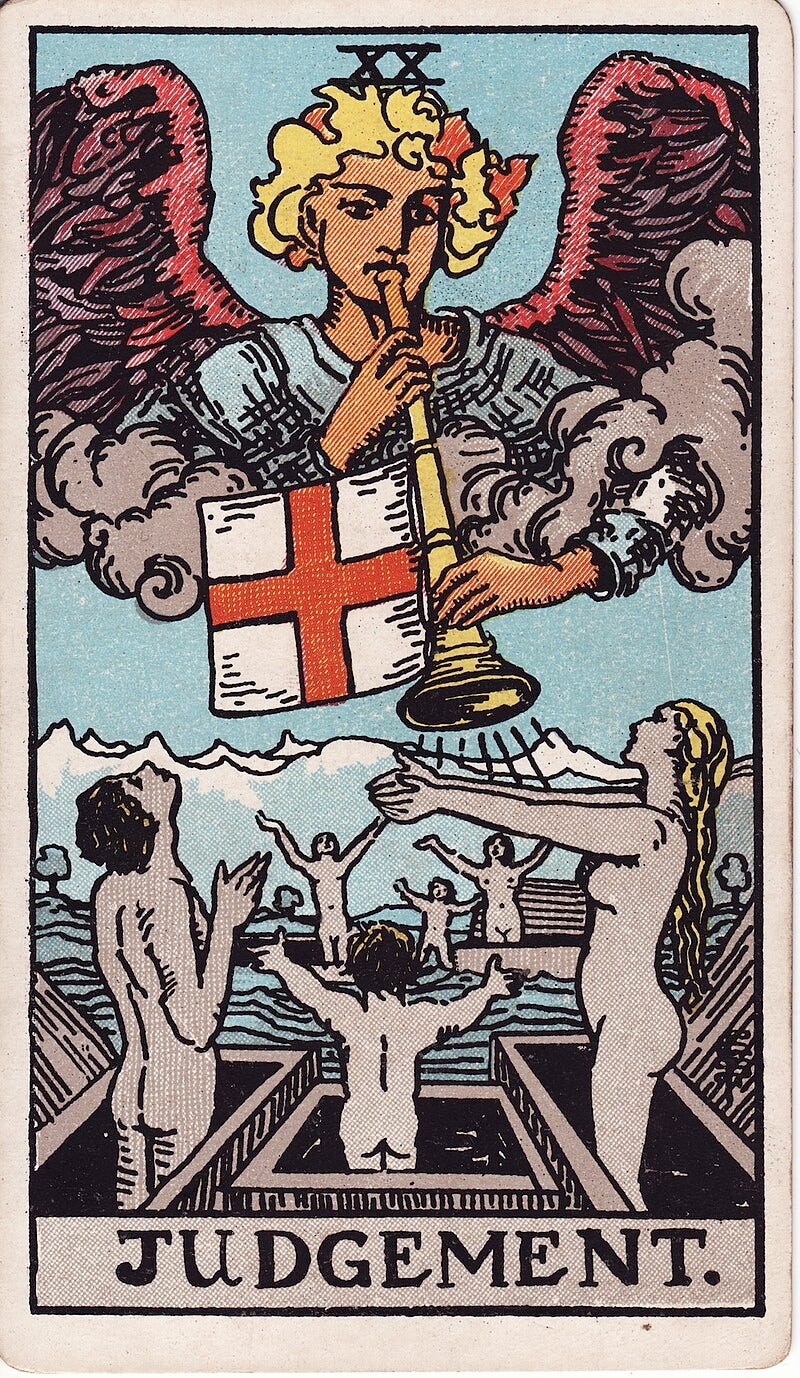
I think it is very important to note, to your point, that Pamela Colman Smith, the artist of the Waite deck, converted to Catholicism after making these cards, was counted very pious, and took care of retired priests. She died in poverty, but by all accounts, happier than when she'd been involved in occult circles. But her Bible had illustrations from the Tarot in the margins. There's a lot here to unpack. Love your article as usual. RT
I applaud your courage.
I have been working with Tarot for much of my life. I have been trying to introduce it to the Right on substack, working on a series detailing each card. I find nothing in the Tarot that is hostile to Christianity. But I invariably lose subscribers each time I write about the esoteric. I appreciate and am saving this piece.
This is my latest, on III. The Empress
https://williamhunterduncan.substack.com/p/iii-the-empress